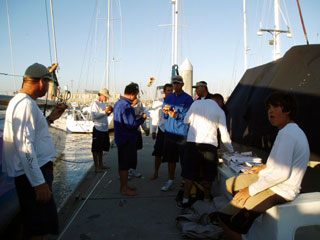Friday July 4th
Happy 4th of July. For the team at Pegasus Racing, its a lot of focus and work on Friday, July 4th. That’s because we decided to get it all done and give the whole team Saturday the 5th off. Time to relax and get psyched up for the big event. Just like a big exam, cramming won’t help. We’ve done all that we could do, now our dice are cast. Of course in the navigation part of the team we’re going to be very busy crunching weather information. Most of the team is going to go for a big workout at the gym, jogging or biking. This will be the last big workout before a 7 day match race. And that must be one of the longest match races of modern sailing history: 2250 nautical miles of non-stop adrenaline, 24 hours a day without respite.
There are 4 distinct parts to the Transpac race:
Part 1: Getting out of the coastline into the offshore winds. Big gains or big losses can be made here. We’re starting at 1 PM, probably before the seabreeze will be established and there is quite a bit of adverse current. Our goal at the start is to stay in touch with our competitor. We don’t need to be ahead, just close enough that we don’t make significant losses. This is the same kind of approach that we took successfully during Coastal Cup a few weeks ago.
Part 2: Reaching in the Northwesterly gradient breeze all the way to the ridge that is attached to the South-Eastern part of the Pacific high. That’s where we’ll meet the North-Easterly tradewinds. How far South do we go? How much more distance should we sail in order to find more wind? Because Pegasus 77 is a sled and planes, every knot of increased windspeed means 1/2 knot of increased boat speed off the wind.
Part 3: Running in the trades and surfing to Hawaii. Sailing to Hawaii is surfing to Hawaii: You want to take down every wave that is surfable. And that’s lots of fun.
Part 4: The last 500 nautical Miles where we have to sail with those tricky squalls all around. With these squalls, the wind gets shifted right at the front end but where there is almost no wind in the back. In the last 100 miles we need to find the right line to head for the Diamond Head finish line. And there are a lot of decisions to be made then as to how far to get across the Molokai channel to find better wind and a better angle to the finish, again trading more distance for more boat speed.
Of course weather models change quickly and so by Sunday morning we’ll have a pretty good game plan for the first couple of days, but then, we’ll need to continue crunching weather information in the navigation station. This makes the Transpac very much a navigator’s race because sleds like Pegasus 77 are so responsive to increased wind speeds.
